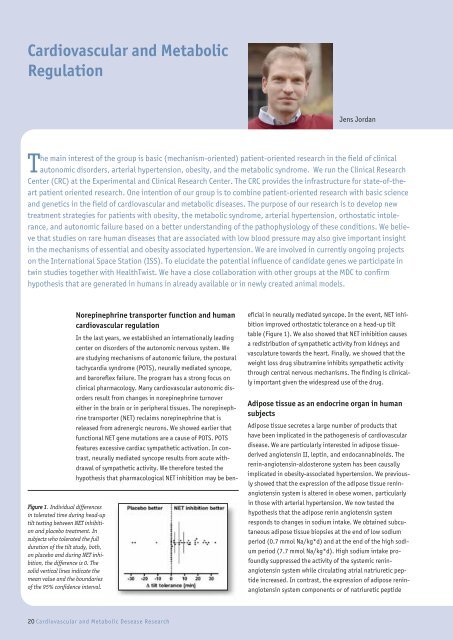of the Max - MDC
of the Max - MDC
of the Max - MDC
You also want an ePaper? Increase the reach of your titles
YUMPU automatically turns print PDFs into web optimized ePapers that Google loves.
Cardiovascular and Metabolic<br />
Regulation<br />
Jens Jordan<br />
The main interest <strong>of</strong> <strong>the</strong> group is basic (mechanism-oriented) patient-oriented research in <strong>the</strong> field <strong>of</strong> clinical<br />
autonomic disorders, arterial hypertension, obesity, and <strong>the</strong> metabolic syndrome. We run <strong>the</strong> Clinical Research<br />
Center (CRC) at <strong>the</strong> Experimental and Clinical Research Center. The CRC provides <strong>the</strong> infrastructure for state-<strong>of</strong>-<strong>the</strong>art<br />
patient oriented research. One intention <strong>of</strong> our group is to combine patient-oriented research with basic science<br />
and genetics in <strong>the</strong> field <strong>of</strong> cardiovascular and metabolic diseases. The purpose <strong>of</strong> our research is to develop new<br />
treatment strategies for patients with obesity, <strong>the</strong> metabolic syndrome, arterial hypertension, orthostatic intolerance,<br />
and autonomic failure based on a better understanding <strong>of</strong> <strong>the</strong> pathophysiology <strong>of</strong> <strong>the</strong>se conditions. We believe<br />
that studies on rare human diseases that are associated with low blood pressure may also give important insight<br />
in <strong>the</strong> mechanisms <strong>of</strong> essential and obesity associated hypertension. We are involved in currently ongoing projects<br />
on <strong>the</strong> International Space Station (ISS). To elucidate <strong>the</strong> potential influence <strong>of</strong> candidate genes we participate in<br />
twin studies toge<strong>the</strong>r with HealthTwist. We have a close collaboration with o<strong>the</strong>r groups at <strong>the</strong> <strong>MDC</strong> to confirm<br />
hypo<strong>the</strong>sis that are generated in humans in already available or in newly created animal models.<br />
Figure 1. Individual differences<br />
in tolerated time during head-up<br />
tilt testing between NET inhibition<br />
and placebo treatment. In<br />
subjects who tolerated <strong>the</strong> full<br />
duration <strong>of</strong> <strong>the</strong> tilt study, both,<br />
on placebo and during NET inhibition,<br />
<strong>the</strong> difference is 0. The<br />
solid vertical lines indicate <strong>the</strong><br />
mean value and <strong>the</strong> boundaries<br />
<strong>of</strong> <strong>the</strong> 95% confidence interval.<br />
Norepinephrine transporter function and human<br />
cardiovascular regulation<br />
In <strong>the</strong> last years, we established an internationally leading<br />
center on disorders <strong>of</strong> <strong>the</strong> autonomic nervous system. We<br />
are studying mechanisms <strong>of</strong> autonomic failure, <strong>the</strong> postural<br />
tachycardia syndrome (POTS), neurally mediated syncope,<br />
and baroreflex failure. The program has a strong focus on<br />
clinical pharmacology. Many cardiovascular autonomic disorders<br />
result from changes in norepinephrine turnover<br />
ei<strong>the</strong>r in <strong>the</strong> brain or in peripheral tissues. The norepinephrine<br />
transporter (NET) reclaims norepinephrine that is<br />
released from adrenergic neurons. We showed earlier that<br />
functional NET gene mutations are a cause <strong>of</strong> POTS. POTS<br />
features excessive cardiac sympa<strong>the</strong>tic activation. In contrast,<br />
neurally mediated syncope results from acute withdrawal<br />
<strong>of</strong> sympa<strong>the</strong>tic activity. We <strong>the</strong>refore tested <strong>the</strong><br />
hypo<strong>the</strong>sis that pharmacological NET inhibition may be beneficial<br />
in neurally mediated syncope. In <strong>the</strong> event, NET inhibition<br />
improved orthostatic tolerance on a head-up tilt<br />
table (Figure 1). We also showed that NET inhibition causes<br />
a redistribution <strong>of</strong> sympa<strong>the</strong>tic activity from kidneys and<br />
vasculature towards <strong>the</strong> heart. Finally, we showed that <strong>the</strong><br />
weight loss drug sibutramine inhibits sympa<strong>the</strong>tic activity<br />
through central nervous mechanisms. The finding is clinically<br />
important given <strong>the</strong> widespread use <strong>of</strong> <strong>the</strong> drug.<br />
Adipose tissue as an endocrine organ in human<br />
subjects<br />
Adipose tissue secretes a large number <strong>of</strong> products that<br />
have been implicated in <strong>the</strong> pathogenesis <strong>of</strong> cardiovascular<br />
disease. We are particularly interested in adipose tissuederived<br />
angiotensin II, leptin, and endocannabinoids. The<br />
renin-angiotensin-aldosterone system has been causally<br />
implicated in obesity-associated hypertension. We previously<br />
showed that <strong>the</strong> expression <strong>of</strong> <strong>the</strong> adipose tissue reninangiotensin<br />
system is altered in obese women, particularly<br />
in those with arterial hypertension. We now tested <strong>the</strong><br />
hypo<strong>the</strong>sis that <strong>the</strong> adipose renin angiotensin system<br />
responds to changes in sodium intake. We obtained subcutaneous<br />
adipose tissue biopsies at <strong>the</strong> end <strong>of</strong> low sodium<br />
period (0.7 mmol Na/kg*d) and at <strong>the</strong> end <strong>of</strong> <strong>the</strong> high sodium<br />
period (7.7 mmol Na/kg*d). High sodium intake pr<strong>of</strong>oundly<br />
suppressed <strong>the</strong> activity <strong>of</strong> <strong>the</strong> systemic reninangiotensin<br />
system while circulating atrial natriuretic peptide<br />
increased. In contrast, <strong>the</strong> expression <strong>of</strong> adipose reninangiotensin<br />
system components or <strong>of</strong> natriuretic peptide<br />
20 Cardiovascular and Metabolic Desease Research
















